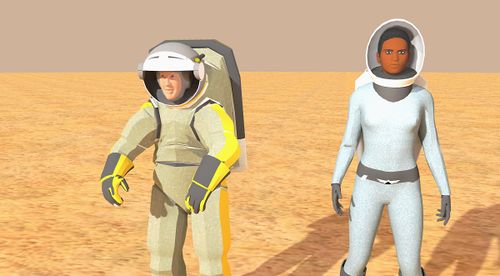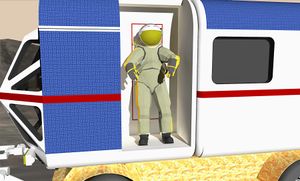Difference between revisions of "EVA Suit"
| Line 7: | Line 7: | ||
This suit provides protection from [[vacuum]], temperature and radiation. It includes telecommunications and autonomous life support. | This suit provides protection from [[vacuum]], temperature and radiation. It includes telecommunications and autonomous life support. | ||
*Life support | *Life support | ||
| − | **Air pressure | + | **Air pressure: Most space suit designs use a design pressure of 4-5 psi, or about 1/3 of normal atmospheric pressure. They use an atmosphere enriched in oxygen to provide sufficient oxygen to the astronauts. |
| + | When changing from normal atmosphere to the lower pressure of the space suit, an adaptation time of 3/4 hours to one hour is required to avoid the risk of decompression sickness (the bends). | ||
| + | |||
**Temperature control | **Temperature control | ||
**CO2 management | **CO2 management | ||
*Dust protection | *Dust protection | ||
*Radiation protection | *Radiation protection | ||
| − | |||
| − | |||
| − | |||
===Pressure suits=== | ===Pressure suits=== | ||
Revision as of 07:30, 23 September 2024
Since the atmospheric pressure on Mars is near vacuum, the settlers will need Space Suits for external operations, such as EVA or surface exploration. Certain areas in the settlements may also be kept at low pressure and require pressure suits. During some periods of the transit to Mars, notably take off and landing, it may be required to wear pressure suits in case of accidental loss of pressure.
Contents
Design requirements
EVA suits
This suit provides protection from vacuum, temperature and radiation. It includes telecommunications and autonomous life support.
- Life support
- Air pressure: Most space suit designs use a design pressure of 4-5 psi, or about 1/3 of normal atmospheric pressure. They use an atmosphere enriched in oxygen to provide sufficient oxygen to the astronauts.
When changing from normal atmosphere to the lower pressure of the space suit, an adaptation time of 3/4 hours to one hour is required to avoid the risk of decompression sickness (the bends).
- Temperature control
- CO2 management
- Dust protection
- Radiation protection
Pressure suits
These would be similar to the suits worn by astronauts during launch, or high altitude pilots. Services such as cooling, air, communications and power would be done through an umbilical connection, to simplify the design and reduce the mass of the suit. These normally operate within a pressurized atmosphere, but offer safety in case of accidental decompression.
Emergency pressure suits
These would be simplified versions of pressure suits and designed to be worn
Type of suits
How to put on a suit
The Russian Orlan spacesuit is entered through the rear, with the backpack acting as a door, whereas the American EMU has various seals at the waist, the helmet, the gloves, the boots, etc. The Russian system can be entered in only five minutes, and with one seal is considerably safer as well.
The rear entry suit can be used with a suitport. This can reduce contamination of the habitat by preventing any ingress of exterior dust.
Pressurized vs. Skintight
- All spacesuits used to date have been pressurized, i.e. filled with air. It can be difficult to move in these suits, and as such they are only pressurized to a third of normal pressure to allow easy movement. To adapt to this low pressure and avoid the risk of nitrogen narcosis an adaptation period is required. This requires the person who will be executing the EVA to breath pure oxygen for a few hours to purge their body of nitrogen, or to reside for up to 45 hours in a gradually lowered atmospheric pressure. This is time consuming and not practical if an emergency EVA were to be carried out.
- An alternative could be a skintight suit, the Mechanical Counterpressure suit, like the biosuit [1]. However, these suits are difficult to enter and exit. At this time, they are also planned to use a pressure of 4-5 psi, and therefore they do not reduce the adaptation time or solve the emergency exit issue.
- Researchers at MIT are working on a spandex and nylon BioSuit to be used in such a situation. The torso would be pressurized to about 30 kPa while the limbs would be sheathed in thinner material allowing for increased dexterity and decreased weight from the current model. [1]
- Rigid suits at full atmospheric pressure have also been researched.
External Link
- ↑ 1.0 1.1 MIT, Dr. Dava Newman Building the Future Spacesuit , https://www.nasa.gov/pdf/617047main_45s_building_future_spacesuit.pdf.








